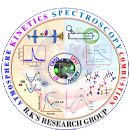In this work, the origin of the singlet and triplet exciton-induced degradation of host materials with C(sp2)–N(sp3) bonds around nitrogen (carbazoles, acridines, etc.), connecting donor and acceptor units, was unravelled using DFT and CASSCF methods. The results reveal that molecules (employed in OLEDs) with basic units containing C(sp2)–N(sp3) bonds (nitrogen connected to carbon in a triangular fashion) have a natural tendency to fragment at the C–N bond through an S1/S0 conical intersection (CI). The calculation of barrier heights, to reach a dissociation point, indicates that degradation via triplet states is kinetically less feasible (ΔGT1–TS* > 25 kcal mol−1) compared to that via the first singlet excited state (ΔGS1–TS* ∼7–30 kcal mol−1). However, the long lifetime of triplets (as compared to singlets) aids in the reverse intersystem crossing from triplet to singlet state for subsequent degradation. From the results and inference, ΔGS1–TS* and ΔES1–T1 are proposed to be the controlling factors for exciton-induced degradation of host materials with C(sp2)–N(sp3) bonds. Furthermore, multiple functionalization of carbazole moieties reveals that polycyclic aromatic systems employed as acceptor units of host materials are best suited for PhOLEDs as they will increase their lifetime due to the larger ΔGS1–TS* and ΔES1–T1. For TADF-based devices, materials with fused ring systems (with N(sp3) at the centre) in the donor unit are the most recommended ones based on the findings of this work, as they avoid the dissociative channel altogether. A negative linear correlation between ΔGS1–TS* and HOMO–LUMO gap is observed, which provides an indirect way to predict the kinetic stability of these materials in excitonic states. These initial results are promising for the future development of the QSAR-type approach for the smart design of host materials for long-life blue OLEDs.
-
Call
-
E-mail
Journal Details
1. Dissociative Nature of C(sp2)-N(sp3) bonds of Carbazole Based Materials via Conical Intersection: Simple Method to Predict the Exciton Stability of Host Materials for blue OLEDs: A Computational Study..
J. Vijaya Sundar & B. Rajakumar. Phys. Chem. Chem. Phys, , 7995-8005., 22
